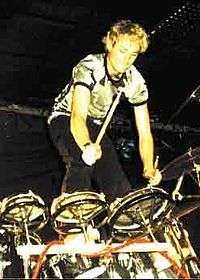Rototom

Rototoms are a drum developed by Al Payson and Michael Colgrass,[1][2] that have no shell and are tuned by rotating. They consist of a single head in a die-cast zinc or aluminum frame. Unlike most other drums, they have a variable definite pitch. Composers are known to write for them as tuned instruments, demanding specific pitches. Rototoms are often used to extend the tom range of a standard drum kit. They were commercialized by the drumhead company Remo.[3]
Tuning
Rototoms can be tuned quickly by rotating the head, which sits in a threaded metal ring. Rotation raises or lowers the tension hoop relative to the rim, which increases or decreases the pitch of the drum by increasing or decreasing the tension of the drum head.
Timpani training
Master James Holland, former percussionist of the London Philharmonic Orchestra, highly recommends them in his book "Percussion",[4] which is part of the Yehudi Menuhin Music Guides series. Rototoms are often used as a training substitute for timpani students, as they have a very similar sound, are not as loud and expensive as timpani, and do not require as much room space.
Notable users

Drummers who used rototoms include Bill Bruford (of Yes, King Crimson and U.K.) and Terry Bozzio (of Frank Zappa's band and U.K.). Roger Taylor of Duran Duran used rototoms extensively on their self-titled debut album Duran Duran of 1981. Roger Taylor of Queen has used rototoms since the early 1970s, most recently in the cover of "Let There Be Drums" on the live album Return of the Champions. Bev Bevan of Electric Light Orchestra used rototom, most notably on the albums Discovery (1979) and Secret Messages (1983). Nick Mason of Pink Floyd used rototoms to record the distinctive introduction to "Time", from the 1973 album The Dark Side of the Moon. The intro to Curtis Mayfield's "Pusherman", heard on the Superfly soundtrack, makes prominent use of the drum's pitch-sliding feature. Phil Collins used rototoms early in his career. Taylor Hawkins of the Foo Fighters includes several rototoms in his drum kit. Alex Van Halen of Van Halen used rototoms extensively on the album 1984.
Other users
- Charly Alberti de Soda Stereo
- Tim Alexander of Primus
- Travis Barker of Blink-182
- Lucius Borich of Cog
- Danny Carey of Tool
- Karen Carpenter of The Carpenters
- Terry Chambers of XTC
- Damon Che of Don Caballero
- Jeremy Colson of Steve Vai's band
- Ray Cooper of Elton John
- Stewart Copeland of The Police
- Alan Myers of Devo
- Rick Buckler of The Jam
- Robert DeLong
- Jon Farriss of INXS
- John Fell of The Heroine Sheiks
- Fenriz of Darkthrone
- Tim Fogarty of El Ten Eleven
- Taylor Hawkins of Foo Fighters
- Arin Ilejay of Avenged Sevenfold
- Darren King of MUTEMATH
- Eric Kretz of Stone Temple Pilots
- Mike Mangini (currently of Dream Theater) while a member of Extreme
- Mike Portnoy formerly of Dream Theater
- Emil Richards (studio percussion legend)[5]
- Pete Sandoval of Morbid Angel
- Shinya of Dir En Grey
- Lol Tolhurst of The Cure
- Tim Walter of The Joes
- Yukihiro of L'Arc-en-Ciel
- Chad Smith of Red Hot Chili Peppers
References
- ↑ Matt Dean (29 December 2011). The Drum: A History. Scarecrow Press. pp. 322–. ISBN 978-0-8108-8171-6. Retrieved 6 January 2013.
- ↑ John Beck (1995). Encyclopedia of Percussion. Taylor & Francis. pp. 79–. ISBN 978-0-8240-4788-7. Retrieved 6 January 2013.
- ↑ Robert M. McCormick (1 March 1985). Percussion for Musicians: A Complete, Fundamental Literature and Technique Method for Percussion. Alfred Music Publishing. pp. 40–. ISBN 978-0-7692-3365-9. Retrieved 6 January 2013.
- ↑ "Percussion", Kahn & Averill Publishers; New Ed edition (June 1, 2001), ISBN 1-871082-39-0
- ↑ "Emil Richards instruments". Emil Richards. Retrieved 19 July 2012.
External links
- Roto Tom Drums fan website
- Photo of rototom closeup
- Photo of rototom in a drum kit
- More pictures of rototom